Business in Practices
VerifiedAdded on 2022/11/29
|10
|2673
|331
AI Summary
This assessment discusses the classification of businesses based on size and scope, organizational structures, and external factors affecting business operations. It explores micro, small, medium, and large businesses, as well as different types of companies from sole traders to cooperatives. The report also examines various organizational structures and how they impact revenue. Additionally, it uses the PESTEL analysis model to explain how external factors influence company performance.
Contribute Materials
Your contribution can guide someone’s learning journey. Share your
documents today.
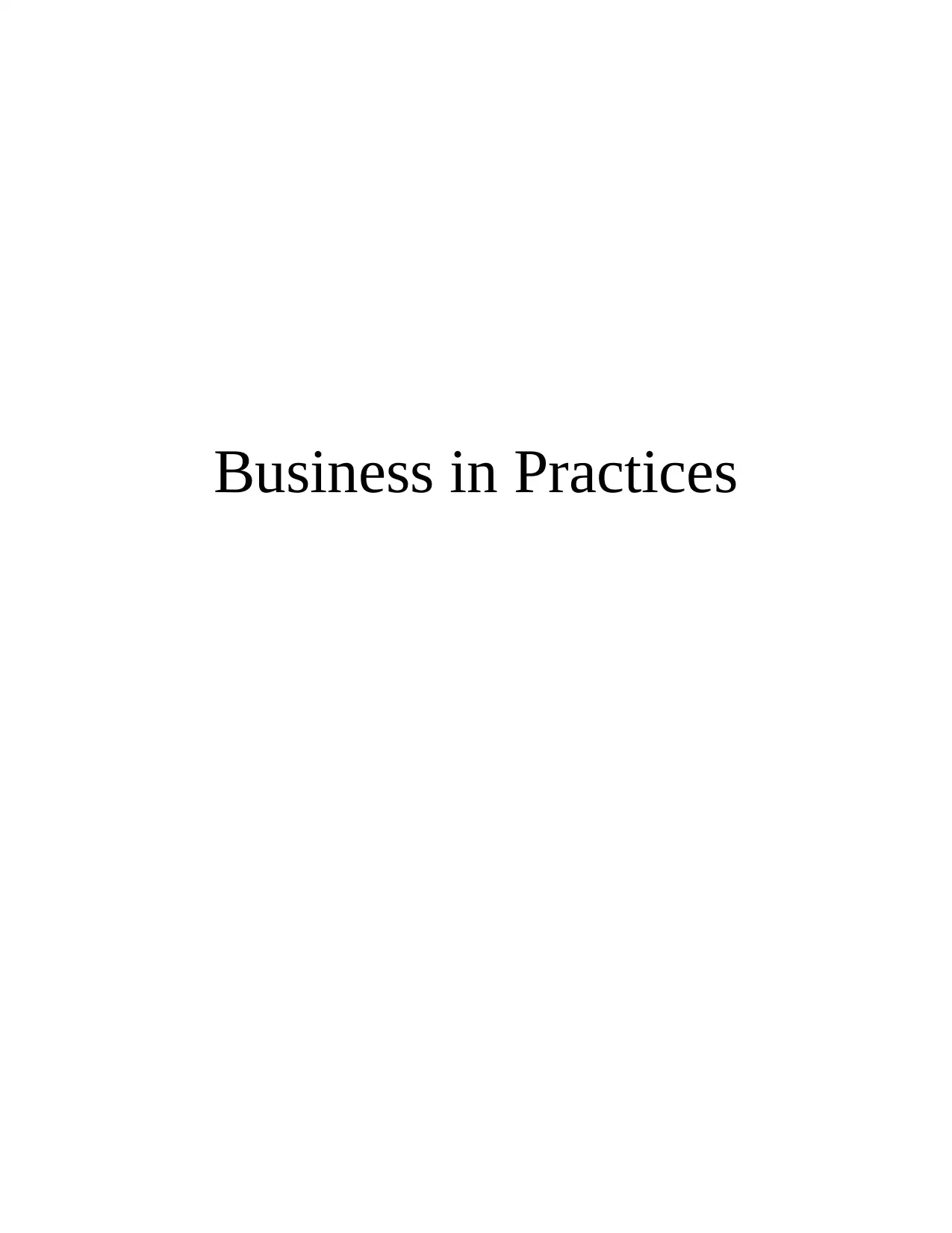
Business in Practices
Secure Best Marks with AI Grader
Need help grading? Try our AI Grader for instant feedback on your assignments.
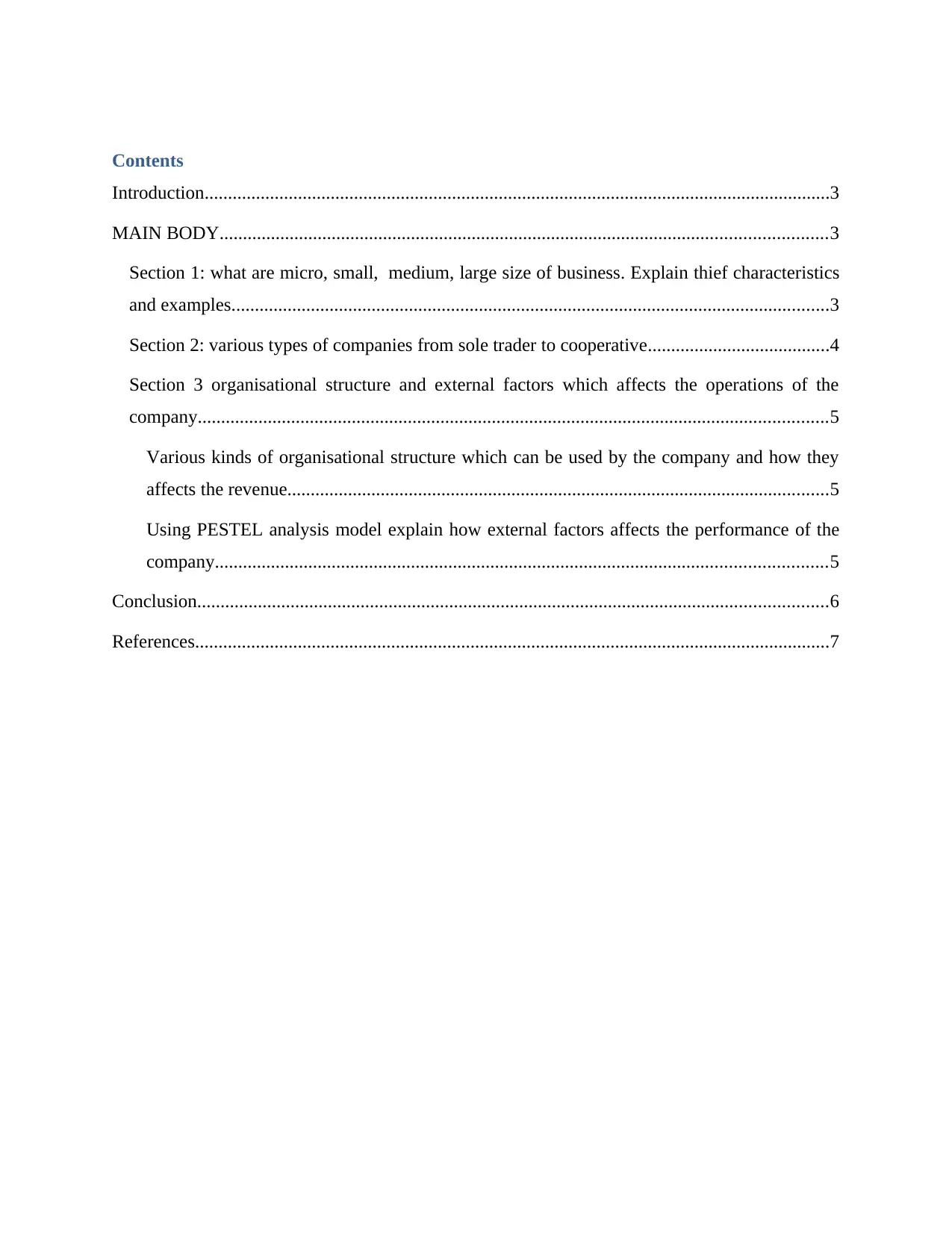
Contents
Introduction......................................................................................................................................3
MAIN BODY..................................................................................................................................3
Section 1: what are micro, small, medium, large size of business. Explain thief characteristics
and examples................................................................................................................................3
Section 2: various types of companies from sole trader to cooperative.......................................4
Section 3 organisational structure and external factors which affects the operations of the
company.......................................................................................................................................5
Various kinds of organisational structure which can be used by the company and how they
affects the revenue....................................................................................................................5
Using PESTEL analysis model explain how external factors affects the performance of the
company...................................................................................................................................5
Conclusion.......................................................................................................................................6
References........................................................................................................................................7
Introduction......................................................................................................................................3
MAIN BODY..................................................................................................................................3
Section 1: what are micro, small, medium, large size of business. Explain thief characteristics
and examples................................................................................................................................3
Section 2: various types of companies from sole trader to cooperative.......................................4
Section 3 organisational structure and external factors which affects the operations of the
company.......................................................................................................................................5
Various kinds of organisational structure which can be used by the company and how they
affects the revenue....................................................................................................................5
Using PESTEL analysis model explain how external factors affects the performance of the
company...................................................................................................................................5
Conclusion.......................................................................................................................................6
References........................................................................................................................................7
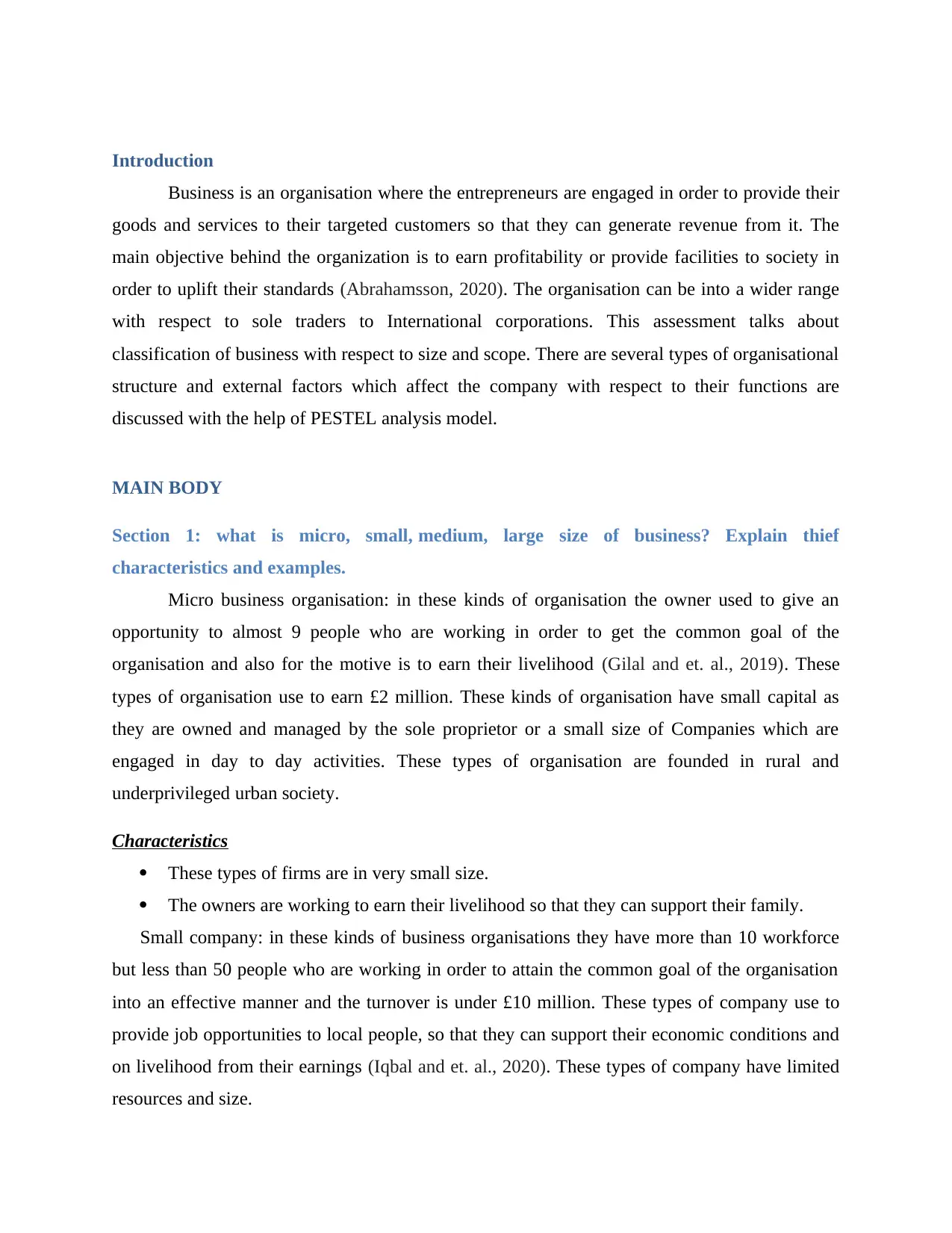
Introduction
Business is an organisation where the entrepreneurs are engaged in order to provide their
goods and services to their targeted customers so that they can generate revenue from it. The
main objective behind the organization is to earn profitability or provide facilities to society in
order to uplift their standards (Abrahamsson, 2020). The organisation can be into a wider range
with respect to sole traders to International corporations. This assessment talks about
classification of business with respect to size and scope. There are several types of organisational
structure and external factors which affect the company with respect to their functions are
discussed with the help of PESTEL analysis model.
MAIN BODY
Section 1: what is micro, small, medium, large size of business? Explain thief
characteristics and examples.
Micro business organisation: in these kinds of organisation the owner used to give an
opportunity to almost 9 people who are working in order to get the common goal of the
organisation and also for the motive is to earn their livelihood (Gilal and et. al., 2019). These
types of organisation use to earn £2 million. These kinds of organisation have small capital as
they are owned and managed by the sole proprietor or a small size of Companies which are
engaged in day to day activities. These types of organisation are founded in rural and
underprivileged urban society.
Characteristics
These types of firms are in very small size.
The owners are working to earn their livelihood so that they can support their family.
Small company: in these kinds of business organisations they have more than 10 workforce
but less than 50 people who are working in order to attain the common goal of the organisation
into an effective manner and the turnover is under £10 million. These types of company use to
provide job opportunities to local people, so that they can support their economic conditions and
on livelihood from their earnings (Iqbal and et. al., 2020). These types of company have limited
resources and size.
Business is an organisation where the entrepreneurs are engaged in order to provide their
goods and services to their targeted customers so that they can generate revenue from it. The
main objective behind the organization is to earn profitability or provide facilities to society in
order to uplift their standards (Abrahamsson, 2020). The organisation can be into a wider range
with respect to sole traders to International corporations. This assessment talks about
classification of business with respect to size and scope. There are several types of organisational
structure and external factors which affect the company with respect to their functions are
discussed with the help of PESTEL analysis model.
MAIN BODY
Section 1: what is micro, small, medium, large size of business? Explain thief
characteristics and examples.
Micro business organisation: in these kinds of organisation the owner used to give an
opportunity to almost 9 people who are working in order to get the common goal of the
organisation and also for the motive is to earn their livelihood (Gilal and et. al., 2019). These
types of organisation use to earn £2 million. These kinds of organisation have small capital as
they are owned and managed by the sole proprietor or a small size of Companies which are
engaged in day to day activities. These types of organisation are founded in rural and
underprivileged urban society.
Characteristics
These types of firms are in very small size.
The owners are working to earn their livelihood so that they can support their family.
Small company: in these kinds of business organisations they have more than 10 workforce
but less than 50 people who are working in order to attain the common goal of the organisation
into an effective manner and the turnover is under £10 million. These types of company use to
provide job opportunities to local people, so that they can support their economic conditions and
on livelihood from their earnings (Iqbal and et. al., 2020). These types of company have limited
resources and size.
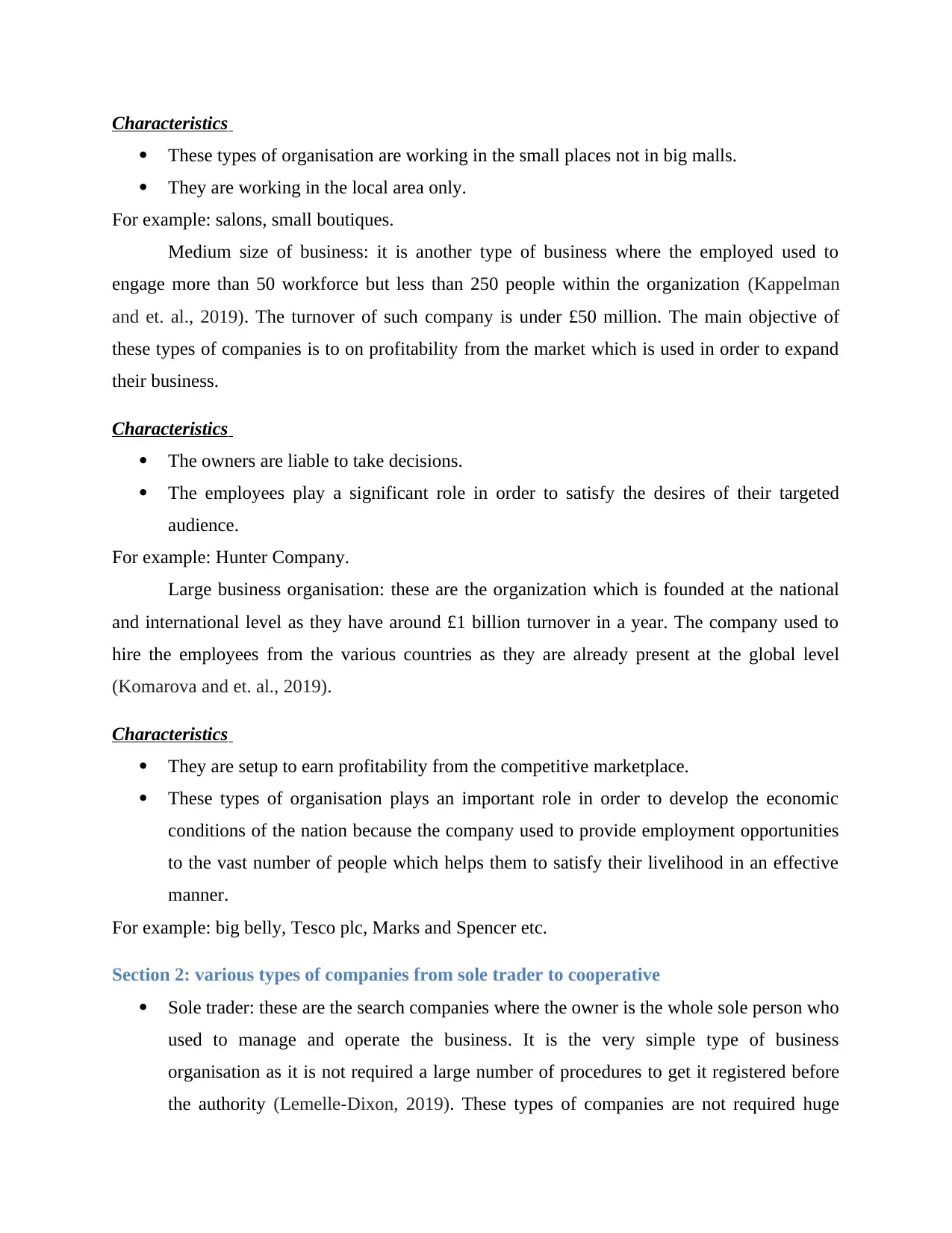
Characteristics
These types of organisation are working in the small places not in big malls.
They are working in the local area only.
For example: salons, small boutiques.
Medium size of business: it is another type of business where the employed used to
engage more than 50 workforce but less than 250 people within the organization (Kappelman
and et. al., 2019). The turnover of such company is under £50 million. The main objective of
these types of companies is to on profitability from the market which is used in order to expand
their business.
Characteristics
The owners are liable to take decisions.
The employees play a significant role in order to satisfy the desires of their targeted
audience.
For example: Hunter Company.
Large business organisation: these are the organization which is founded at the national
and international level as they have around £1 billion turnover in a year. The company used to
hire the employees from the various countries as they are already present at the global level
(Komarova and et. al., 2019).
Characteristics
They are setup to earn profitability from the competitive marketplace.
These types of organisation plays an important role in order to develop the economic
conditions of the nation because the company used to provide employment opportunities
to the vast number of people which helps them to satisfy their livelihood in an effective
manner.
For example: big belly, Tesco plc, Marks and Spencer etc.
Section 2: various types of companies from sole trader to cooperative
Sole trader: these are the search companies where the owner is the whole sole person who
used to manage and operate the business. It is the very simple type of business
organisation as it is not required a large number of procedures to get it registered before
the authority (Lemelle-Dixon, 2019). These types of companies are not required huge
These types of organisation are working in the small places not in big malls.
They are working in the local area only.
For example: salons, small boutiques.
Medium size of business: it is another type of business where the employed used to
engage more than 50 workforce but less than 250 people within the organization (Kappelman
and et. al., 2019). The turnover of such company is under £50 million. The main objective of
these types of companies is to on profitability from the market which is used in order to expand
their business.
Characteristics
The owners are liable to take decisions.
The employees play a significant role in order to satisfy the desires of their targeted
audience.
For example: Hunter Company.
Large business organisation: these are the organization which is founded at the national
and international level as they have around £1 billion turnover in a year. The company used to
hire the employees from the various countries as they are already present at the global level
(Komarova and et. al., 2019).
Characteristics
They are setup to earn profitability from the competitive marketplace.
These types of organisation plays an important role in order to develop the economic
conditions of the nation because the company used to provide employment opportunities
to the vast number of people which helps them to satisfy their livelihood in an effective
manner.
For example: big belly, Tesco plc, Marks and Spencer etc.
Section 2: various types of companies from sole trader to cooperative
Sole trader: these are the search companies where the owner is the whole sole person who
used to manage and operate the business. It is the very simple type of business
organisation as it is not required a large number of procedures to get it registered before
the authority (Lemelle-Dixon, 2019). These types of companies are not required huge
Secure Best Marks with AI Grader
Need help grading? Try our AI Grader for instant feedback on your assignments.
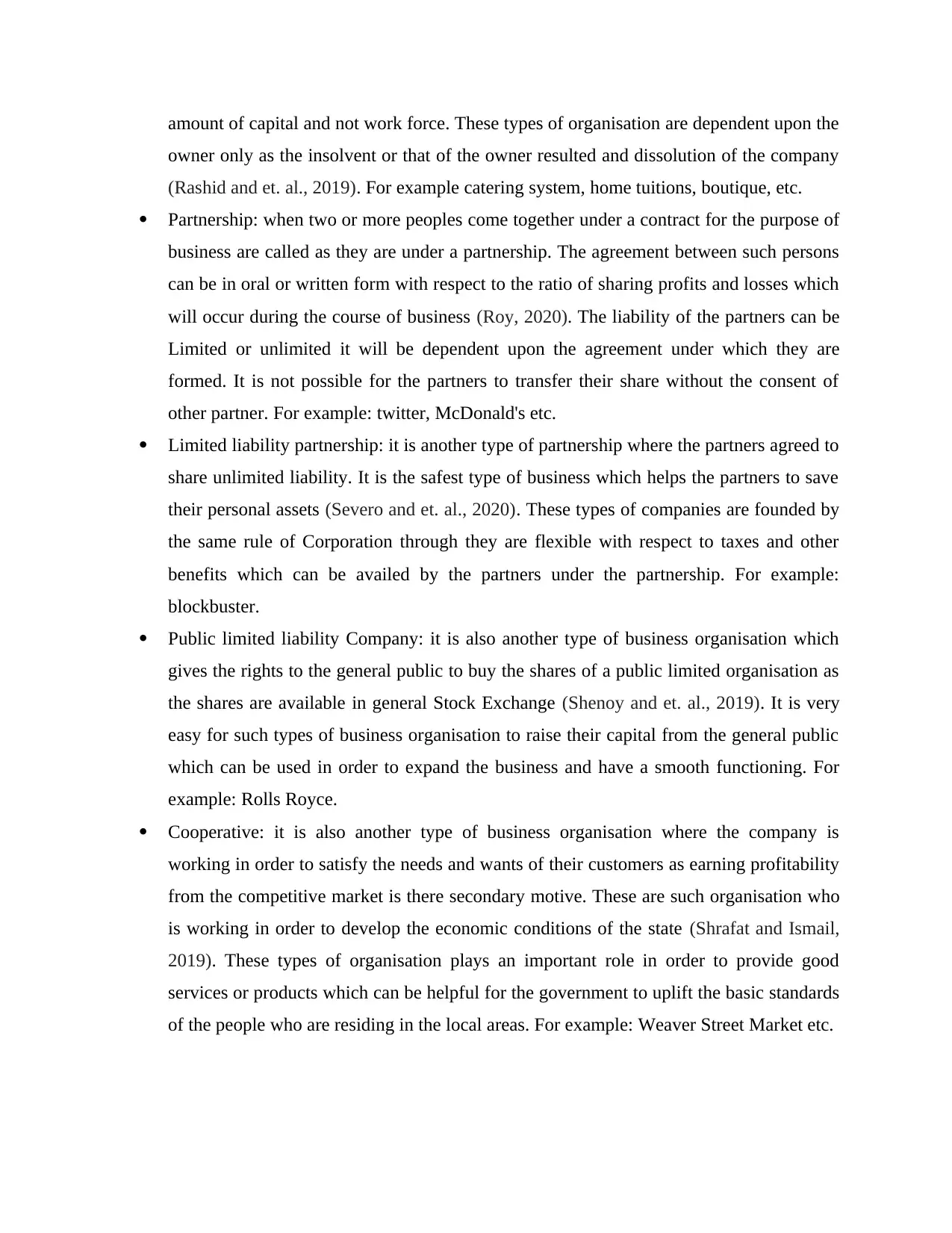
amount of capital and not work force. These types of organisation are dependent upon the
owner only as the insolvent or that of the owner resulted and dissolution of the company
(Rashid and et. al., 2019). For example catering system, home tuitions, boutique, etc.
Partnership: when two or more peoples come together under a contract for the purpose of
business are called as they are under a partnership. The agreement between such persons
can be in oral or written form with respect to the ratio of sharing profits and losses which
will occur during the course of business (Roy, 2020). The liability of the partners can be
Limited or unlimited it will be dependent upon the agreement under which they are
formed. It is not possible for the partners to transfer their share without the consent of
other partner. For example: twitter, McDonald's etc.
Limited liability partnership: it is another type of partnership where the partners agreed to
share unlimited liability. It is the safest type of business which helps the partners to save
their personal assets (Severo and et. al., 2020). These types of companies are founded by
the same rule of Corporation through they are flexible with respect to taxes and other
benefits which can be availed by the partners under the partnership. For example:
blockbuster.
Public limited liability Company: it is also another type of business organisation which
gives the rights to the general public to buy the shares of a public limited organisation as
the shares are available in general Stock Exchange (Shenoy and et. al., 2019). It is very
easy for such types of business organisation to raise their capital from the general public
which can be used in order to expand the business and have a smooth functioning. For
example: Rolls Royce.
Cooperative: it is also another type of business organisation where the company is
working in order to satisfy the needs and wants of their customers as earning profitability
from the competitive market is there secondary motive. These are such organisation who
is working in order to develop the economic conditions of the state (Shrafat and Ismail,
2019). These types of organisation plays an important role in order to provide good
services or products which can be helpful for the government to uplift the basic standards
of the people who are residing in the local areas. For example: Weaver Street Market etc.
owner only as the insolvent or that of the owner resulted and dissolution of the company
(Rashid and et. al., 2019). For example catering system, home tuitions, boutique, etc.
Partnership: when two or more peoples come together under a contract for the purpose of
business are called as they are under a partnership. The agreement between such persons
can be in oral or written form with respect to the ratio of sharing profits and losses which
will occur during the course of business (Roy, 2020). The liability of the partners can be
Limited or unlimited it will be dependent upon the agreement under which they are
formed. It is not possible for the partners to transfer their share without the consent of
other partner. For example: twitter, McDonald's etc.
Limited liability partnership: it is another type of partnership where the partners agreed to
share unlimited liability. It is the safest type of business which helps the partners to save
their personal assets (Severo and et. al., 2020). These types of companies are founded by
the same rule of Corporation through they are flexible with respect to taxes and other
benefits which can be availed by the partners under the partnership. For example:
blockbuster.
Public limited liability Company: it is also another type of business organisation which
gives the rights to the general public to buy the shares of a public limited organisation as
the shares are available in general Stock Exchange (Shenoy and et. al., 2019). It is very
easy for such types of business organisation to raise their capital from the general public
which can be used in order to expand the business and have a smooth functioning. For
example: Rolls Royce.
Cooperative: it is also another type of business organisation where the company is
working in order to satisfy the needs and wants of their customers as earning profitability
from the competitive market is there secondary motive. These are such organisation who
is working in order to develop the economic conditions of the state (Shrafat and Ismail,
2019). These types of organisation plays an important role in order to provide good
services or products which can be helpful for the government to uplift the basic standards
of the people who are residing in the local areas. For example: Weaver Street Market etc.
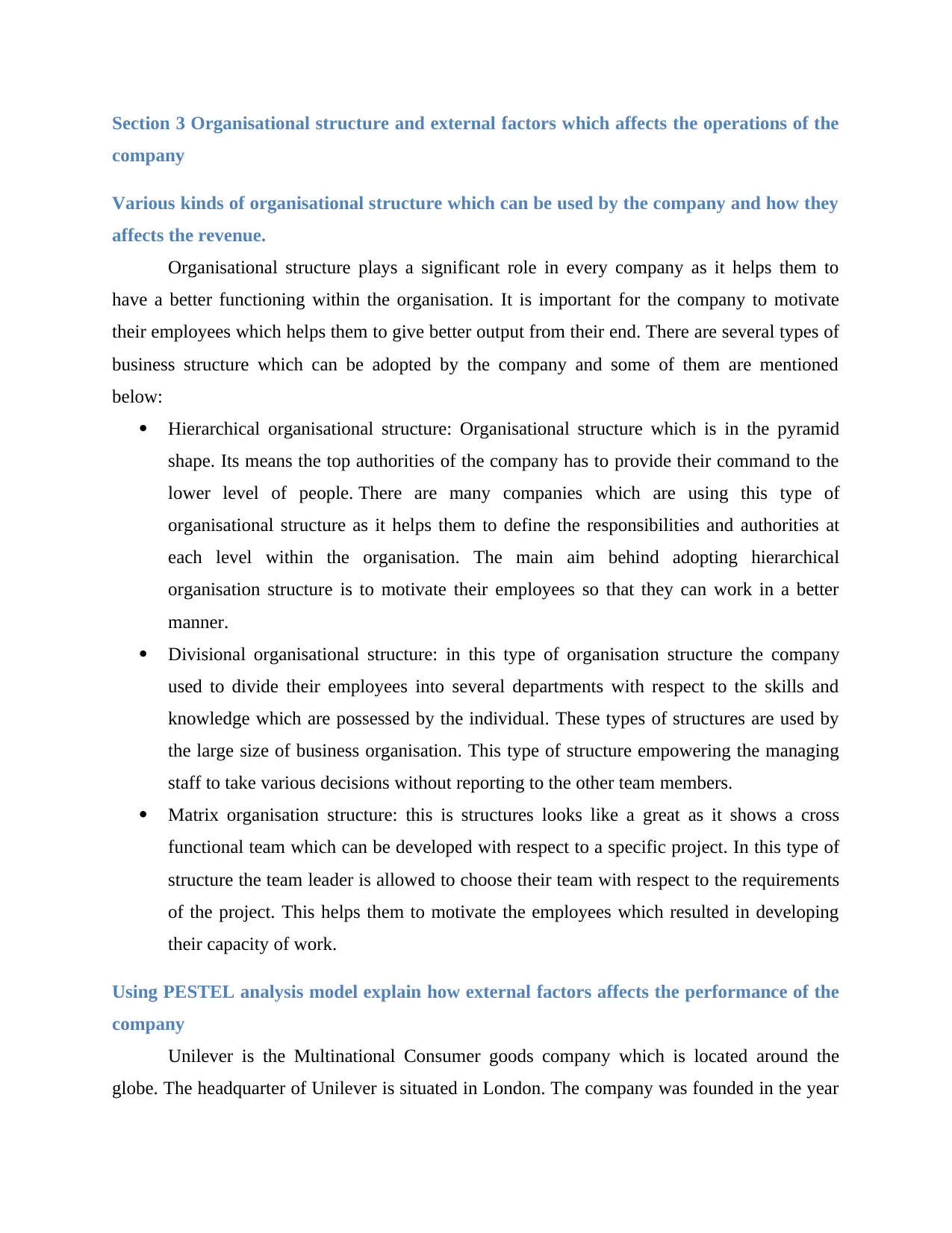
Section 3 Organisational structure and external factors which affects the operations of the
company
Various kinds of organisational structure which can be used by the company and how they
affects the revenue.
Organisational structure plays a significant role in every company as it helps them to
have a better functioning within the organisation. It is important for the company to motivate
their employees which helps them to give better output from their end. There are several types of
business structure which can be adopted by the company and some of them are mentioned
below:
Hierarchical organisational structure: Organisational structure which is in the pyramid
shape. Its means the top authorities of the company has to provide their command to the
lower level of people. There are many companies which are using this type of
organisational structure as it helps them to define the responsibilities and authorities at
each level within the organisation. The main aim behind adopting hierarchical
organisation structure is to motivate their employees so that they can work in a better
manner.
Divisional organisational structure: in this type of organisation structure the company
used to divide their employees into several departments with respect to the skills and
knowledge which are possessed by the individual. These types of structures are used by
the large size of business organisation. This type of structure empowering the managing
staff to take various decisions without reporting to the other team members.
Matrix organisation structure: this is structures looks like a great as it shows a cross
functional team which can be developed with respect to a specific project. In this type of
structure the team leader is allowed to choose their team with respect to the requirements
of the project. This helps them to motivate the employees which resulted in developing
their capacity of work.
Using PESTEL analysis model explain how external factors affects the performance of the
company
Unilever is the Multinational Consumer goods company which is located around the
globe. The headquarter of Unilever is situated in London. The company was founded in the year
company
Various kinds of organisational structure which can be used by the company and how they
affects the revenue.
Organisational structure plays a significant role in every company as it helps them to
have a better functioning within the organisation. It is important for the company to motivate
their employees which helps them to give better output from their end. There are several types of
business structure which can be adopted by the company and some of them are mentioned
below:
Hierarchical organisational structure: Organisational structure which is in the pyramid
shape. Its means the top authorities of the company has to provide their command to the
lower level of people. There are many companies which are using this type of
organisational structure as it helps them to define the responsibilities and authorities at
each level within the organisation. The main aim behind adopting hierarchical
organisation structure is to motivate their employees so that they can work in a better
manner.
Divisional organisational structure: in this type of organisation structure the company
used to divide their employees into several departments with respect to the skills and
knowledge which are possessed by the individual. These types of structures are used by
the large size of business organisation. This type of structure empowering the managing
staff to take various decisions without reporting to the other team members.
Matrix organisation structure: this is structures looks like a great as it shows a cross
functional team which can be developed with respect to a specific project. In this type of
structure the team leader is allowed to choose their team with respect to the requirements
of the project. This helps them to motivate the employees which resulted in developing
their capacity of work.
Using PESTEL analysis model explain how external factors affects the performance of the
company
Unilever is the Multinational Consumer goods company which is located around the
globe. The headquarter of Unilever is situated in London. The company was founded in the year
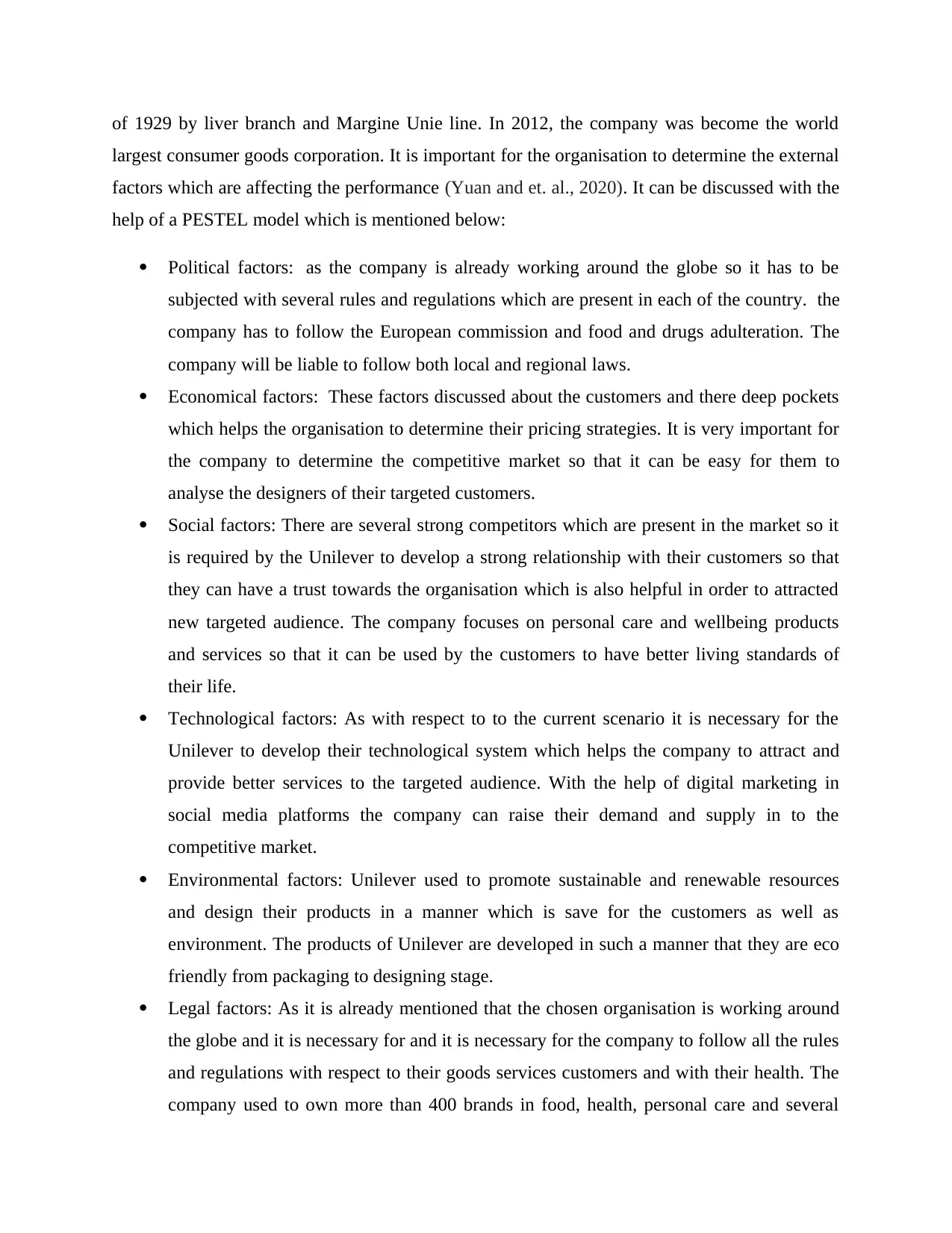
of 1929 by liver branch and Margine Unie line. In 2012, the company was become the world
largest consumer goods corporation. It is important for the organisation to determine the external
factors which are affecting the performance (Yuan and et. al., 2020). It can be discussed with the
help of a PESTEL model which is mentioned below:
Political factors: as the company is already working around the globe so it has to be
subjected with several rules and regulations which are present in each of the country. the
company has to follow the European commission and food and drugs adulteration. The
company will be liable to follow both local and regional laws.
Economical factors: These factors discussed about the customers and there deep pockets
which helps the organisation to determine their pricing strategies. It is very important for
the company to determine the competitive market so that it can be easy for them to
analyse the designers of their targeted customers.
Social factors: There are several strong competitors which are present in the market so it
is required by the Unilever to develop a strong relationship with their customers so that
they can have a trust towards the organisation which is also helpful in order to attracted
new targeted audience. The company focuses on personal care and wellbeing products
and services so that it can be used by the customers to have better living standards of
their life.
Technological factors: As with respect to to the current scenario it is necessary for the
Unilever to develop their technological system which helps the company to attract and
provide better services to the targeted audience. With the help of digital marketing in
social media platforms the company can raise their demand and supply in to the
competitive market.
Environmental factors: Unilever used to promote sustainable and renewable resources
and design their products in a manner which is save for the customers as well as
environment. The products of Unilever are developed in such a manner that they are eco
friendly from packaging to designing stage.
Legal factors: As it is already mentioned that the chosen organisation is working around
the globe and it is necessary for and it is necessary for the company to follow all the rules
and regulations with respect to their goods services customers and with their health. The
company used to own more than 400 brands in food, health, personal care and several
largest consumer goods corporation. It is important for the organisation to determine the external
factors which are affecting the performance (Yuan and et. al., 2020). It can be discussed with the
help of a PESTEL model which is mentioned below:
Political factors: as the company is already working around the globe so it has to be
subjected with several rules and regulations which are present in each of the country. the
company has to follow the European commission and food and drugs adulteration. The
company will be liable to follow both local and regional laws.
Economical factors: These factors discussed about the customers and there deep pockets
which helps the organisation to determine their pricing strategies. It is very important for
the company to determine the competitive market so that it can be easy for them to
analyse the designers of their targeted customers.
Social factors: There are several strong competitors which are present in the market so it
is required by the Unilever to develop a strong relationship with their customers so that
they can have a trust towards the organisation which is also helpful in order to attracted
new targeted audience. The company focuses on personal care and wellbeing products
and services so that it can be used by the customers to have better living standards of
their life.
Technological factors: As with respect to to the current scenario it is necessary for the
Unilever to develop their technological system which helps the company to attract and
provide better services to the targeted audience. With the help of digital marketing in
social media platforms the company can raise their demand and supply in to the
competitive market.
Environmental factors: Unilever used to promote sustainable and renewable resources
and design their products in a manner which is save for the customers as well as
environment. The products of Unilever are developed in such a manner that they are eco
friendly from packaging to designing stage.
Legal factors: As it is already mentioned that the chosen organisation is working around
the globe and it is necessary for and it is necessary for the company to follow all the rules
and regulations with respect to their goods services customers and with their health. The
company used to own more than 400 brands in food, health, personal care and several
Paraphrase This Document
Need a fresh take? Get an instant paraphrase of this document with our AI Paraphraser
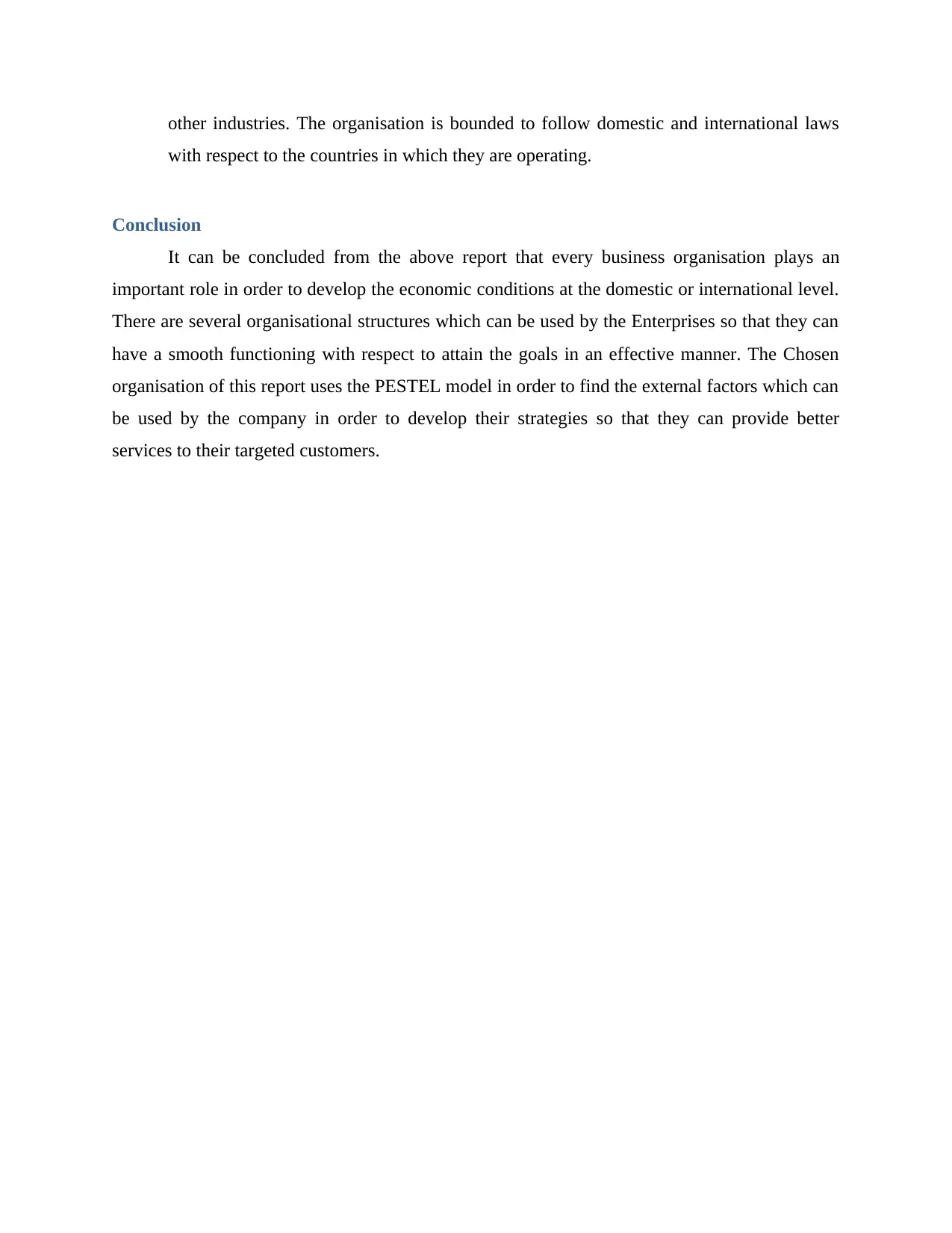
other industries. The organisation is bounded to follow domestic and international laws
with respect to the countries in which they are operating.
Conclusion
It can be concluded from the above report that every business organisation plays an
important role in order to develop the economic conditions at the domestic or international level.
There are several organisational structures which can be used by the Enterprises so that they can
have a smooth functioning with respect to attain the goals in an effective manner. The Chosen
organisation of this report uses the PESTEL model in order to find the external factors which can
be used by the company in order to develop their strategies so that they can provide better
services to their targeted customers.
with respect to the countries in which they are operating.
Conclusion
It can be concluded from the above report that every business organisation plays an
important role in order to develop the economic conditions at the domestic or international level.
There are several organisational structures which can be used by the Enterprises so that they can
have a smooth functioning with respect to attain the goals in an effective manner. The Chosen
organisation of this report uses the PESTEL model in order to find the external factors which can
be used by the company in order to develop their strategies so that they can provide better
services to their targeted customers.
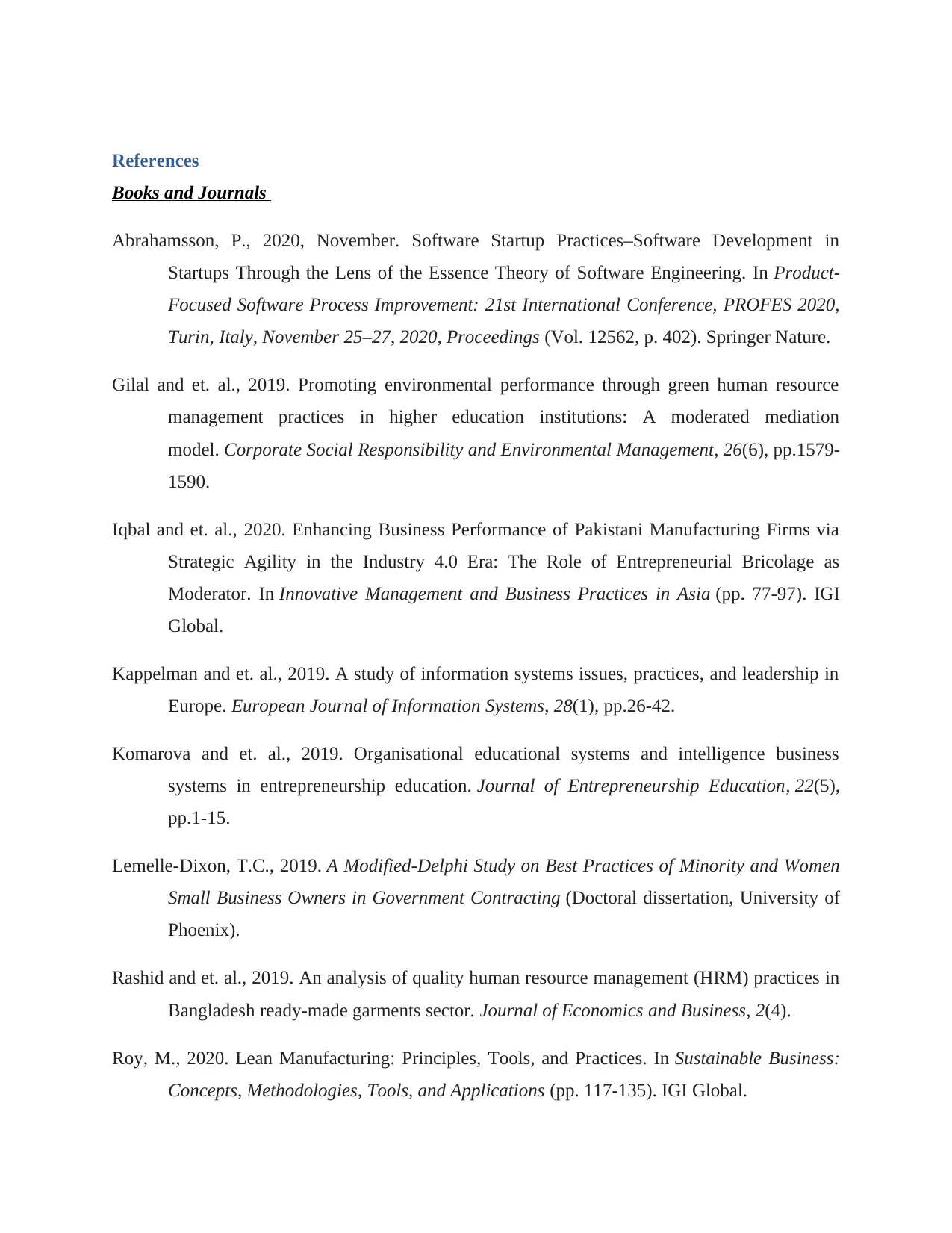
References
Books and Journals
Abrahamsson, P., 2020, November. Software Startup Practices–Software Development in
Startups Through the Lens of the Essence Theory of Software Engineering. In Product-
Focused Software Process Improvement: 21st International Conference, PROFES 2020,
Turin, Italy, November 25–27, 2020, Proceedings (Vol. 12562, p. 402). Springer Nature.
Gilal and et. al., 2019. Promoting environmental performance through green human resource
management practices in higher education institutions: A moderated mediation
model. Corporate Social Responsibility and Environmental Management, 26(6), pp.1579-
1590.
Iqbal and et. al., 2020. Enhancing Business Performance of Pakistani Manufacturing Firms via
Strategic Agility in the Industry 4.0 Era: The Role of Entrepreneurial Bricolage as
Moderator. In Innovative Management and Business Practices in Asia (pp. 77-97). IGI
Global.
Kappelman and et. al., 2019. A study of information systems issues, practices, and leadership in
Europe. European Journal of Information Systems, 28(1), pp.26-42.
Komarova and et. al., 2019. Organisational educational systems and intelligence business
systems in entrepreneurship education. Journal of Entrepreneurship Education, 22(5),
pp.1-15.
Lemelle-Dixon, T.C., 2019. A Modified-Delphi Study on Best Practices of Minority and Women
Small Business Owners in Government Contracting (Doctoral dissertation, University of
Phoenix).
Rashid and et. al., 2019. An analysis of quality human resource management (HRM) practices in
Bangladesh ready-made garments sector. Journal of Economics and Business, 2(4).
Roy, M., 2020. Lean Manufacturing: Principles, Tools, and Practices. In Sustainable Business:
Concepts, Methodologies, Tools, and Applications (pp. 117-135). IGI Global.
Books and Journals
Abrahamsson, P., 2020, November. Software Startup Practices–Software Development in
Startups Through the Lens of the Essence Theory of Software Engineering. In Product-
Focused Software Process Improvement: 21st International Conference, PROFES 2020,
Turin, Italy, November 25–27, 2020, Proceedings (Vol. 12562, p. 402). Springer Nature.
Gilal and et. al., 2019. Promoting environmental performance through green human resource
management practices in higher education institutions: A moderated mediation
model. Corporate Social Responsibility and Environmental Management, 26(6), pp.1579-
1590.
Iqbal and et. al., 2020. Enhancing Business Performance of Pakistani Manufacturing Firms via
Strategic Agility in the Industry 4.0 Era: The Role of Entrepreneurial Bricolage as
Moderator. In Innovative Management and Business Practices in Asia (pp. 77-97). IGI
Global.
Kappelman and et. al., 2019. A study of information systems issues, practices, and leadership in
Europe. European Journal of Information Systems, 28(1), pp.26-42.
Komarova and et. al., 2019. Organisational educational systems and intelligence business
systems in entrepreneurship education. Journal of Entrepreneurship Education, 22(5),
pp.1-15.
Lemelle-Dixon, T.C., 2019. A Modified-Delphi Study on Best Practices of Minority and Women
Small Business Owners in Government Contracting (Doctoral dissertation, University of
Phoenix).
Rashid and et. al., 2019. An analysis of quality human resource management (HRM) practices in
Bangladesh ready-made garments sector. Journal of Economics and Business, 2(4).
Roy, M., 2020. Lean Manufacturing: Principles, Tools, and Practices. In Sustainable Business:
Concepts, Methodologies, Tools, and Applications (pp. 117-135). IGI Global.
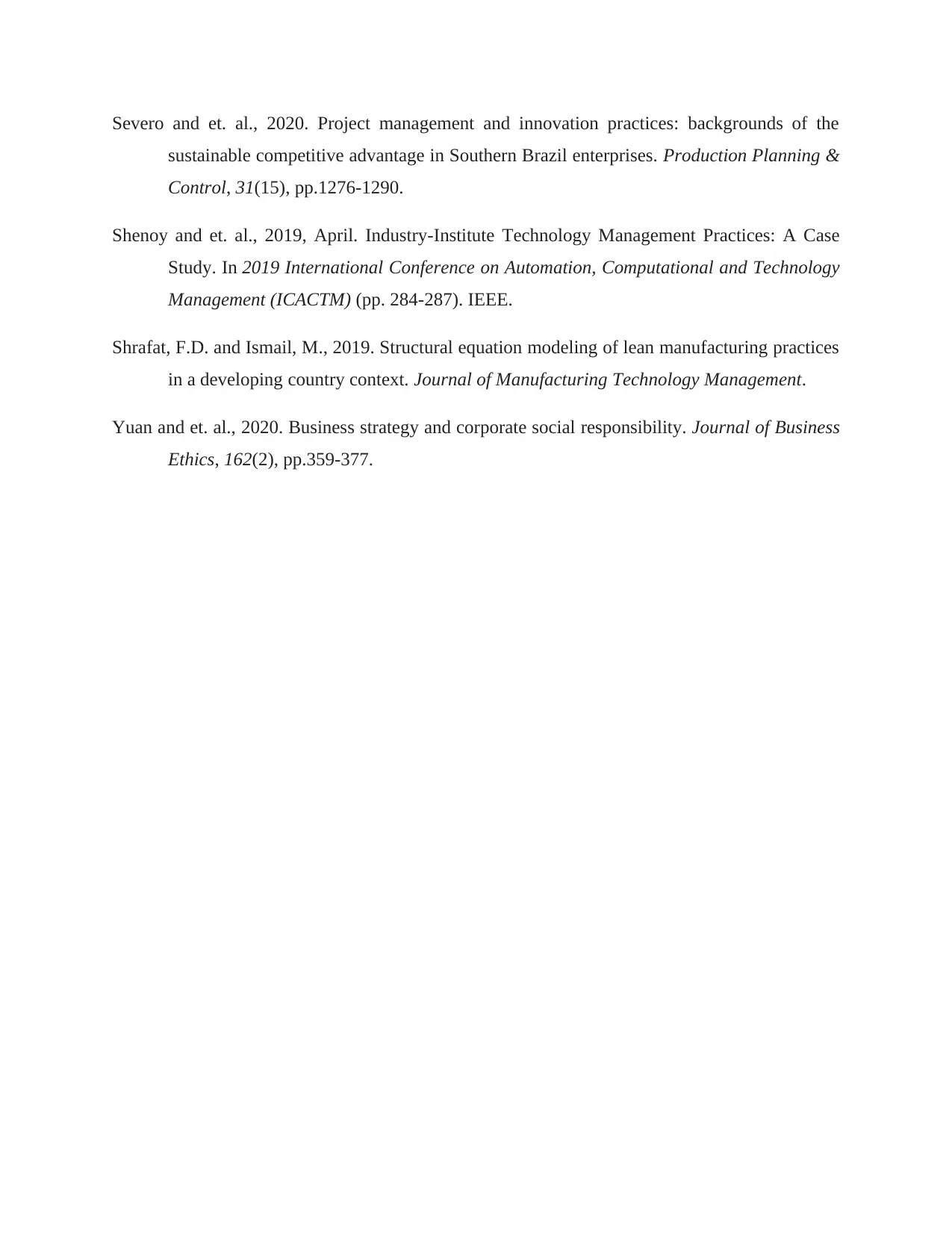
Severo and et. al., 2020. Project management and innovation practices: backgrounds of the
sustainable competitive advantage in Southern Brazil enterprises. Production Planning &
Control, 31(15), pp.1276-1290.
Shenoy and et. al., 2019, April. Industry-Institute Technology Management Practices: A Case
Study. In 2019 International Conference on Automation, Computational and Technology
Management (ICACTM) (pp. 284-287). IEEE.
Shrafat, F.D. and Ismail, M., 2019. Structural equation modeling of lean manufacturing practices
in a developing country context. Journal of Manufacturing Technology Management.
Yuan and et. al., 2020. Business strategy and corporate social responsibility. Journal of Business
Ethics, 162(2), pp.359-377.
sustainable competitive advantage in Southern Brazil enterprises. Production Planning &
Control, 31(15), pp.1276-1290.
Shenoy and et. al., 2019, April. Industry-Institute Technology Management Practices: A Case
Study. In 2019 International Conference on Automation, Computational and Technology
Management (ICACTM) (pp. 284-287). IEEE.
Shrafat, F.D. and Ismail, M., 2019. Structural equation modeling of lean manufacturing practices
in a developing country context. Journal of Manufacturing Technology Management.
Yuan and et. al., 2020. Business strategy and corporate social responsibility. Journal of Business
Ethics, 162(2), pp.359-377.
1 out of 10
Related Documents
Your All-in-One AI-Powered Toolkit for Academic Success.
+13062052269
info@desklib.com
Available 24*7 on WhatsApp / Email
![[object Object]](/_next/static/media/star-bottom.7253800d.svg)
Unlock your academic potential
© 2024 | Zucol Services PVT LTD | All rights reserved.





